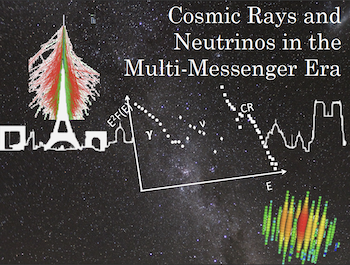Description
High-energy neutrinos are considered the smoking gun signature for identifying hadronic acceleration sites. High-energy cosmic rays interact with ambient matter or photon fields to produce charged and neutral pions. Neutral pions decay to gamma rays, but charged pions produce neutrinos in their decay chain. While high-energy gamma rays can also be produced in leptonic processes such as Inverse Compton scattering and Bremsstrahlung, neutrinos are solely produced in hadronic processes.
A flux of high-energy astrophysical neutrinos was first discovered by the IceCube Neutrino observatory in 2013, and there has since been an ongoing search looking for the origins of this flux. A promising strategy to identify the neutrino sources is to search for their electromagnetic counterpart. To increase sensitivity to transient and variable sources, since 2016 the IceCube collaboration has issued real-time high-energy neutrino alerts. In 2017, one neutrino alert (IC170922A) was associated with the flaring blazar TXS 0506+056. In 2019, a second neutrino alert (IC191001A) was associated with the tidal disruption event (TDE) AT2019dsg.
We perform a systematic search for electromagnetic counterparts by following up all IceCube alerts for which observations with the Zwicky Transient Facility (ZTF) are possible. ZTF is an optical telescope with a unique 47 sq. deg. field of view. So far, we have observed 29% of all 55 IceCube alerts since April 2018. The TDE cited above was found during this search.
Here we report observations of AT2019fdr, a bright nuclear transient in a Narrow-Line Seyfert 1 (NLSy1) galaxy, that we have identified as coincident with high-energy neutrino IceCube-200530A. The transient is most likely a TDE, like AT2019dsg. We performed and analyzed observations of AT2019fdr in the optical (ZTF), UV (Swift) and near infrared (WISE and Palomar P200). The source was not detected in X-Ray (Swift) and Gamma-Ray (Fermi).
| Related session | Multi-messenger |
|---|

